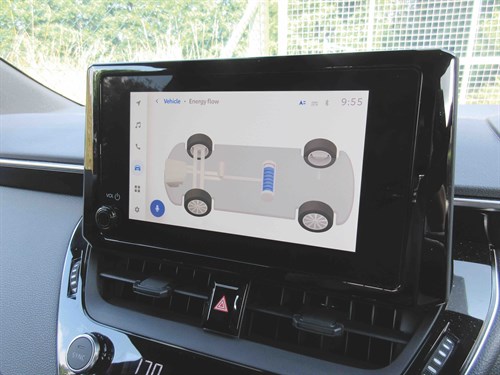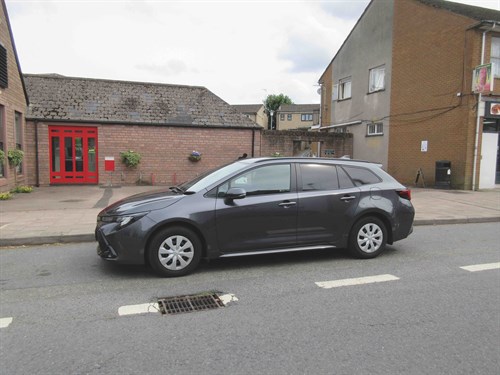- Further 4.25t electric van rule changes under consideration
- Arval research uncovers van fleet optimism
- Pre-orders open for new Nissan Interstar
- More than half of UK van drivers now believe EVs more cost effective than ICE, VW finds
- Public EV charging costs preventing adoption for some fleets, AFP says
- Ford Ranger Tremor review
- Inseego awarded Crown Commercial Service framework status
- ADVERTISEMENT FEATURE: Electrify and optimise: Digital solutions at the forefront of decarbonisation
- Fleets being pushed to take electric vans due to ZEV mandate, AFP reports
- Buying a used... Citroen Relay (2019)
Toyota Corolla Commercial long-term test – Final Report
Date: Friday, October 13, 2023 | Author: Steve Banner
5th Report
As somebody who views most manufacturers' built-in sat-nav systems with a jaundiced eye – they always want to send me to Warsaw when I want to go to Walsall – I must admit to being impressed by the one installed in Corolla Commercial. It’s simple to use, gives clear directions and, while the dashboard touchscreen is comparatively small compared with the huge screens now being fitted to some light commercials, the map is easy to follow.
In fact, the system is so good it has prompted me to abandon my trusty old Garmin; that’s right, the one you stick to the windscreen using a sucker that leaves a tell-tale round mark. Aside from any other consideration, the 12V power socket I would need to trail its cable to is inside a lidded compartment between the seats – goodness knows why Toyota has put it there – rather than on the fascia.
Idly tapping the touchscreen allows you to access a variety of useful pieces of data as well as create your own in-cab Wi-Fi hotspot. Worth a look is a neat schematic that tells you how much energy is being pumped into and out of the van’s battery.

Average fuel consumption is now 59.4mpg according to the on-board computer but rose to a very creditable 60.1mpg on my last journey, which involved a run down the M4 in appalling wet weather and a trundle around central London in typically heavy traffic. At least I had the Toyota’s exemplary DAB radio for company and was able to use the gear lever’s B setting – designed to increase the level of regeneration – as a retarder to (hopefully) help prevent me from breaching the capital’s near-ubiquitous 20mph speed limit.
The touchscreen can also tell you how much range you have left before you need to visit a petrol station; so there is no need to panic and resort to filling up on the motorway at rip-off prices because you’re frightened you will run dry. The same useful bit of information is duplicated on the instrument panel.
When you want to refuel Corolla Commercial incidentally, don’t forget to tug the lever near the bottom of the driver’s seat that pops open the fuel flap. I keep forgetting – usually in the pouring rain – and have to walk back round to do the necessary.
Sensibly, Toyota does not expect drivers to use the touchscreen to operate everything. The heating, ventilation and air conditioning system are controlled by a row of buttons and knobs just under the screen, so all you need to do is press or twist the appropriate one if you want to boost the fan speed or increase the temperature.
The package allows you and your fellow passenger to set separate temperatures according to your personal preferences and it works effectively. Just as well given that
my usual travelling companion likes it baking hot while I’m only really happy if icicles start to form above the windscreen.
I’ve previously made reference to the space left under the load bed where the spare wheel would usually be, and its usefulness as a repository for items you would prefer not to have stolen. It can swallow any number of smartphones, tablets and laptops, not to mention power tools, and I crammed it full of kit on a recent trip.
That said, I’d still rather have a spare wheel than be obliged to rely on one of those pesky inflator/sealers in an emergency.
Yes, I know it adds weight, but I also know that Britain’s roads are in an atrocious state and are getting worse; and the sort of punctures some potholes can inflict would defeat most inflator/sealers and leave a hapless van driver stranded.
Report card: Load area = 4/5
Easy to access with a handy hidden compartment.
Toyota Corolla Commercial
Mileage 2,996
Official combined fuel economy (WLTP) 55.6mpg
Our average consumption 59.4mpg
Price (ex VAT) £23,553
Warranty 10yrs/100,000mls
Service intervals 1yr/10,000mls
Load length 1558mm
Load width (min/max) 952mm/1430mm
Load bay height 682mm
Load volume 1.3m3
Gross payload 425kg
Engine size/power 1798cc, 120hp
CO2 115g/km
4th Report
Press a little button next to the gear shift and you’ve just switched the self-charging hybrid Corolla Commercial to battery power only; but don’t think you’ll be able to travel from Lands End to John O’ Groats by doing so.
Run solely on battery power and you will just about manage two or three miles if you are gentle with the throttle before the juice runs out and the petrol engine kicks in; and does so smoothly, incidentally. Makes you wonder why Toyota has bothered fitting a button that offers drivers a choice that, on the face of it, seems like no real choice at all.
As it happens, it makes sound sense. Vans sometimes have to enter warehouses, exhibition halls and other enclosed spaces where running a diesel or petrol engine is a big no-no because of the exhaust emissions. Select zero-emission battery power only for the 100 yards – if that – you’ll be travelling once you’re through the doors, and you’ll be complying with the rules.
Go battery-only and you will be running quietly too; something that can only be applauded if you are pulling into premises surrounded by houses and their slumbering residents late at night. Likewise, if you are delivering items to a hospital or a clinic out
-of-hours.

Remember to drive that bit more carefully if you switch to battery power though. Pedestrians, cyclists and other vulnerable road users rely on their ears (often blocked with earbuds, alas) as much as their eyes (often directed towards a smartphone screen, unfortunately) and may be oblivious to your presence.
Just as well then that Corolla Commercial has more built-in safety devices than you can shake a stick at. The line-up includes Toyato’s Pre-Collision System, which brakes the
van automatically if the driver ignores a warning that they are about to hit something.
What it does not include are reversing sensors, as I’ve pointed out before.
Sorry to harp on about this Toyota, but you really need to make them standard. Their absence is a major gap in the van’s safety armoury.
Putting this gripe to one side, after more than 2,500 miles, our long-term demonstrator is performing remarkably well. I’ve not found its limited payload capacity to be a particular problem, the load area has swallowed everything I’ve asked it to and the ability to get at it from three sides has proved to be a boon when parked in narrow side streets in Welsh towns.
No matter whether you take it down a motorway or along a twisting rural B-road, it performs well. While the steering can feel a little dead at times, the handling isn’t compromised and the van rides comfortably.
It is also proving to be increasingly fuel efficient.
I’m now averaging around 57mpg, a little bit ahead of the WLTP combined consumption figure, possibly because I’m making full use of the Eco setting. Switching to Sport is a temptation given the major jump in acceleration it delivers, but one that I’m for the most part managing to resist.
The Toyota is proving to be reliable, and nothing has broken or fallen off.
It’s also proving to be a bit of a surprise to casual passers-by who can’t believe that it’s a van; until you point out the opaque rear side windows and show them the load area.
For many prospective users who do not want something that is clearly a commercial vehicle parked on their drive, that might be its biggest plus-point. Yes, it’s a van – but at least it has the common decency to be discreet about it.
Report card: Fuel economy = 4/5
Gets better and better.
Toyota Corolla Commercial
Mileage 2,590
Official combined fuel economy (WLTP) 55.6mpg
Our average consumption 57mpg
Price (ex VAT) £23,553
Warranty 10yrs/100,000mls
Service intervals 1yr/10,000mls
Load length 1558mm
Load width (min/max) 952mm/1430mm
Load bay height 682mm
Load volume 1.3m3
Gross payload 425kg
Engine size/power 1798cc, 120hp
CO2 115g/km
View The WhatVan Digital Edition


